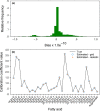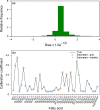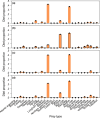Simultaneous estimation of diet composition and calibration coefficients with fatty acid signature data
- PMID: 28861216
- PMCID: PMC5574754
- DOI: 10.1002/ece3.3179
Simultaneous estimation of diet composition and calibration coefficients with fatty acid signature data
Abstract
Knowledge of animal diets provides essential insights into their life history and ecology, although diet estimation is challenging and remains an active area of research. Quantitative fatty acid signature analysis (QFASA) has become a popular method of estimating diet composition, especially for marine species. A primary assumption of QFASA is that constants called calibration coefficients, which account for the differential metabolism of individual fatty acids, are known. In practice, however, calibration coefficients are not known, but rather have been estimated in feeding trials with captive animals of a limited number of model species. The impossibility of verifying the accuracy of feeding trial derived calibration coefficients to estimate the diets of wild animals is a foundational problem with QFASA that has generated considerable criticism. We present a new model that allows simultaneous estimation of diet composition and calibration coefficients based only on fatty acid signature samples from wild predators and potential prey. Our model performed almost flawlessly in four tests with constructed examples, estimating both diet proportions and calibration coefficients with essentially no error. We also applied the model to data from Chukchi Sea polar bears, obtaining diet estimates that were more diverse than estimates conditioned on feeding trial calibration coefficients. Our model avoids bias in diet estimates caused by conditioning on inaccurate calibration coefficients, invalidates the primary criticism of QFASA, eliminates the need to conduct feeding trials solely for diet estimation, and consequently expands the utility of fatty acid data to investigate aspects of ecology linked to animal diets.
Keywords: QFASA; diet estimation; food web; qfasar; quantitative fatty acid signature analysis.
Figures









References
-
- Aitchison, J. (1986). The statistical analysis of compositional data (p. 416). New York, NY: Chapman and Hall.
-
- Beatty, W. S. , Jay, C. V. , Fischbach, A. S. , Grebmeier, J. M. , Taylor, R. L. , Blanchard, A. L. , & Jewett, S. C. (2016). Space use of a dominant arctic vertebrate: Effects of prey, sea ice, and land on Pacific walrus resource selection. Biological Conservation, 203, 25–32.
-
- Beck, C. A. , Iverson, S. J. , Bowen, W. D. , & Blanchard, W. (2007). Sex differences in grey seal diet reflect seasonal variation in foraging behaviour and reproductive expenditure: Evidence from quantitative fatty acid signature analysis. Journal of Animal Ecology, 76, 490–502. - PubMed
-
- Bowen, W. D. , & Iverson, S. J. (2013). Methods of estimating marine mammal diets: A review of validation experiments and sources of bias and uncertainty. Marine Mammal Science, 29, 719–754.
-
- Bowles, E. , Schulte, P. M. , Tollit, D. J. , Deagle, B. E. , & Trites, A. W. (2011). Proportion of prey consumed can be determined from faecal DNA using real‐time PCR. Molecular Ecology Resources, 11, 530–540. - PubMed
LinkOut - more resources
Full Text Sources
Other Literature Sources

